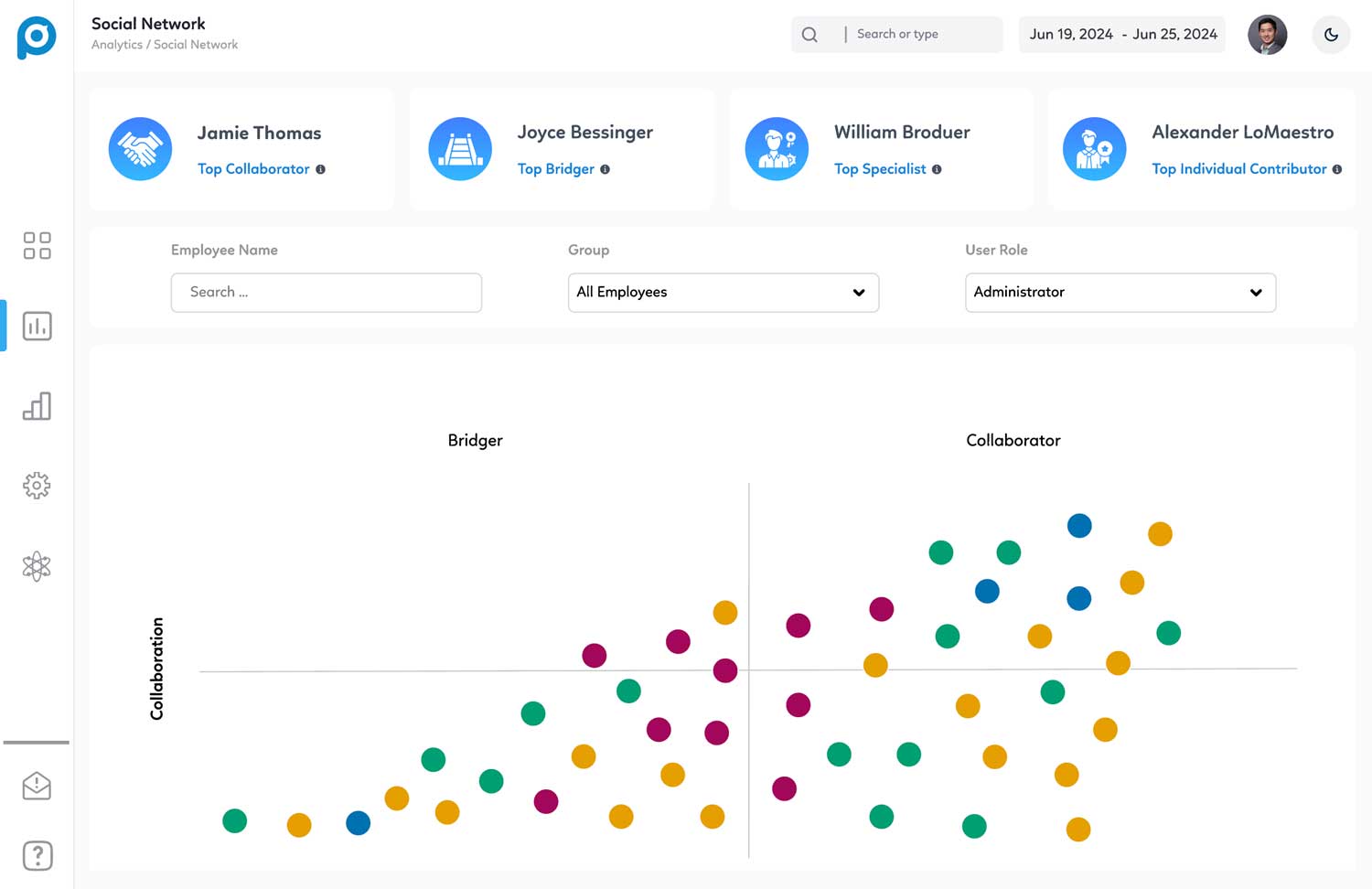Unlocking Leadership Potential with Collaboration Insights: How to Find Hidden Leaders Within Your Organization
Have you ever wondered if certain employees are management material who have been completely passed over? You may have an employee who doesn’t have specific qualifications that you would consider necessary to promote to management, but is responsible for an entire department. Or, you may have a manager working in a silo who doesn’t communicate with their team.
You may suspect this is happening, but how can you tell? Understanding the strengths and patterns of internal collaboration within an organization can reveal hidden leadership potential and areas that need improvement.
By measuring these interactions, it's possible to identify key influencers, critical connectors between teams, and communication gaps. These insights, available through Organizational Network Analysis (ONA), provide valuable data to support internal promotions and address employee disengagement without requiring extensive prior leadership training. However, such training opportunities should still be available to give employees the confidence they need in a new management role.
What is Organizational Network Analysis?
Organizational Network Analysis provides insight into the strength and types of internal collaboration between people. Before its development, there was no good quantitative way to measure company collaboration. You can visualize your business's internal social network with an ONA solution, empowering organizations to:
- Identify key influencers who act as internal resources - they are often the “go-to” for questions or to help with onboarding new hires.
- Hone in on critical connectors, or employees who act as a bridge between teams and individuals. Critical connectors initiate cross-functional projects, facilitate knowledge sharing sessions, and bridge department communication gaps.
- Visualize how people interact with each other to get a visual representation of communication patterns. See the frequency and nature of interactions and how information flows between individuals and teams.
- Understand where communication gaps exist so you know where communication is lacking or inefficient and can identify potential bottlenecks.
- Plan company growth and internal reorganizations with objective evidence of existing interaction patterns to design teams, allocate resources, and restructure departments to optimize collaboration and efficiency.
- Be proactive about employee disengagement and know when employees become increasingly isolated or disconnected from their colleagues. By recognizing these patterns, you can intervene proactively, address any underlying issues, and prevent potential turnover.
- Mitigate silos on teams or within departments to encourage cross-functional collaboration and improve teamwork.
- Pinpoint the “quiet ones” who hold your company together and reward them.
- Coach team members who may initially feel uncomfortable contacting colleagues and gauge how quickly new hires acclimate.
Insights from ONA and internal collaboration data are compelling, enabling managers and organizations to make better-informed business decisions.
Using Internal Collaboration Data to Identify Employees With Leadership Potential
Employees with leadership potential must exhibit certain qualities, and how they collaborate internally is a key factor. Ideally, they are frequent collaborators, critical connectors, and highly connected. Prodoscore data also suggests a correlation between high collaboration and high productivity, so employees with leadership potential are often top performers.
Leaders who are naturally strong connectors foster a more inclusive and supportive team environment, leading to higher employee satisfaction. Being a critical connector often demonstrates strong networking, communication, and problem-solving abilities, essential for effective leadership. When managers have very little interaction with their team members, it usually means they are not managing effectively or setting up their people for success.
Identifying leaders through collaboration allows for targeted workforce development plans. By recognizing employees with strong collaboration skills, we can provide them with leadership training tailored to their specific strengths and areas for growth.
Disadvantages of Promoting without Collaboration Data
Promotions based solely on traditional metrics (i.e., tenure, job title) can be biased and overlook talented, highly effective collaborators who may not have traditional 'leadership' credentials. Certain employees may already be informally leading and influencing others without your knowledge. Ignoring collaboration data means you risk promoting someone who 'looks good on paper' but lacks the social capital to lead a team effectively.
Subjective biases or 'office politics' can play a larger role in promotion decisions without data on actual interactions, leading to inequity. Most commonly, a top individual performer who gets promoted is not effective in a leadership position because they cannot connect and communicate with their team.
Promoting the "wrong" person can demotivate teams, damage morale, and increase turnover. In the bigger picture, consistently overlooking collaboration data can create a culture where individual achievements are valued over teamwork, hindering innovation and overall organizational success.
How Does Prodoscore Measure Organizational Network Analysis?
Prodoscore’s Organizational Network Analysis solution showcases how team members interact and share information.

On an individual level, you can see who communicates with who most frequently and who may be in a silo with little to no communication with others. The same holds true for departments and teams, where you can visualize the relationship between the various groups and understand where collaboration is and isn’t taking place.
Do you want to better understand employee engagement and pinpoint employees with leadership potential?
